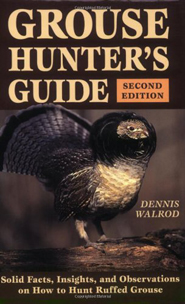
Grouse Hunting Season Begins Oct. 1 in NY
ARTICLE BY INDREK KONGATS, SEPTEMBER 28, 2016

On Oct. 1, ruffed grouse hunting season opens in most of New York State, including here in Cattaraugus and Erie counties. Personally it is my favorite of all the upland game bird species, dating back to my childhood when my grandfather took me out on our 100-acre farm. Grouse were plentiful back then. Itís a wonder I didnít die of fright each time a bird flushed! With such a thunderous and unexpected sudden roar, I swear itís enough to make you wet your pants. Maybe that early introduction to grouse hunting is the reason I canít enjoy scary movies to this day, oh the horror!
Since my grandfatherís passing, I have enjoyed grouse hunting with numerous hunting partners, including Dennis Walrod of nearby Lakewood, NY. Dennis is the author of the Grouse Hunterís Guide, a book he published back in 1985, still in print and available on Amazon.com. Dennis and I first met about 16 years ago at, of all places, a fly fishing show at the Chautauqua Institute. We had booths across from one another; I was booking Arctic Fishing Excursions and he was promoting his grouse book.After staring at each other all day, we started asking each other questions about our specialties and found that we both had more grouse hunting in common than fishing.
One thing lead to another and I invited Dennis out hunting in my neck of the woods on the state land along the Zoar Valley. Iím not an exceptionally talented grouse hunter, but I do run across one every once in a while. Cleverly, I thought I could get Dennis to evaluate my turf and show me a thing or two. Unfortunately, there wasnít much to show since we didnít hear or see a single bird. What I did learn was that the habitat that we were hunting was excellent. Thatís what I was hoping for. With good habitat, your odds improve tenfold.
One of the things that Dennis told me was that at one time Western New York was void of trees. When we look out the window today, we see rolling hills covered in deciduous and coniferous forests, not so 120 years ago these same hills where mostly covered in fields of grass and shrub. As the new forests started growing, so did the habitat for the grouse.
Grouse flourished for a good while until the forests began to mature. Grouse hunting has been on the decline for the past 25 years because of this very fact, but thatís not the only reasonópredation, encroachment are among others.
Grouse feed on buds and wild fruit from all sorts of trees and shrubs, which are very vital to the health and wealth of the grouse population. New growth close to the ground also offers easy feeding and shelter. Mixed forests have deciduous trees that offer an abundance of food, and evergreens offer shelter and protection against inclement winter storms.
An ideal plant is the cranberry bush viburnum. This plant has a twofold benefit for the grouse. One, the red berries are an important food source and once covered with snow, the heavily laden branches droop to the ground and create a sort of igloo for the birds. One could call it a dive-in restaurant. 
According to Dennis, once the hunter has discovered the right mix of habitat that also holds birds, he has discovered what is called a covert. From his book he writes, ďA covert is a possession of mind, of memories, a special place where the hunter walks, knowing that at any instant a ruffed grouse can shatter tranquility and thereby stake claim to a share of that ownership.Ē A hunter stakes his claim to each and every covert much like a gold miner chasing El Dorado. Whether he shares his good fortune with just his most trusted hunting companion, his dog or feels generous and shares it with another hunter, itís a place of memories.
Hunting grouse isnít easy and according to DEC statistics, a hunter will flush one bird for every hour of hunting and after 15 flushes, will bag one birdónot very high odds. The odds are even worse if you donít hunt with a dog. Dogs are invaluable to the grouse hunter. They can go as Captain Kirk would say, ďto boldly go where no man has ever gone before.Ē Depending on breed, dogs will either point or flush a bird that the hunter had no inkling was even there, giving the hunter, more than the bird, a fighting chance.
Cover is the grouseís greatest ally and for that reason, few flushes offer clean shots. Your odds improve dramatically once the leaves have fallen at the end of October, but that presents another dilemmaóturkey season has started!
I personally would like to thank Dennis Walrod for giving me permission to share his thoughts and ideas and to quote from his great book.
back to main menu

|